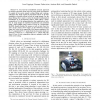Free Online Productivity Tools
i2Speak
i2Symbol
i2OCR
iTex2Img
iWeb2Print
iWeb2Shot
i2Type
iPdf2Split
iPdf2Merge
i2Bopomofo
i2Arabic
i2Style
i2Image
i2PDF
iLatex2Rtf
Sci2ools
IROS
2008
IEEE
2008
IEEE
Fast plane detection and polygonalization in noisy 3D range images
— A very fast but nevertheless accurate approach for surface extraction from noisy 3D point clouds is presented. It consists of two parts, namely a plane fitting and a polygonalization step. Both exploit the sequential nature of 3D data acquisition on mobile robots in form of range images. For the plane fitting, this is used to revise the standard mathematical formulation to an incremental version, which allows a linear computation. For the polygonalization, the neighborhood relation in range images is exploited. Experiments are presented using a time-of-flight range camera in form of a Swissranger SR-3000. Results include lab scenes as well as data from two runs of the rescue robot league at the RoboCup German Open 2007 with 1,414, respectively 2,343 sensor snapshots. The 36·106 , respectively 59·106 points from the two point clouds are reduced to about 14·103 , respectively 23·103 planes with only about 0.2 sec of total computation time per snapshot while the robot moves alo...
IROS 2008 | Noisy 3D Point | Point Clouds | Range Images | Robotics |
| Added | 31 May 2010 |
| Updated | 09 Feb 2012 |
| Type | Conference |
| Year | 2008 |
| Where | IROS |
| Authors | Jann Poppinga, Narunas Vaskevicius, Andreas Birk 0002, Kaustubh Pathak |
Comments (0)

